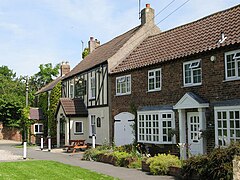Kirklington, North Yorkshire
| Kirklington | |
|---|---|
 Kirklington Village |
|
| Kirklington shown within North Yorkshire | |
| Population | 220 |
| OS grid reference | SE319810 |
| Civil parish | |
| District | |
| Shire county | |
| Region | |
| Country | England |
| Sovereign state | United Kingdom |
| Post town | DARLINGTON |
| Postcode district | DL8 2 |
| Police | North Yorkshire |
| Fire | North Yorkshire |
| Ambulance | Yorkshire |
| EU Parliament | Yorkshire and the Humber |
| UK Parliament | |
Kirklington is a village in the English county of North Yorkshire close to the A1. Kirklington forms the major part of the civil parish of Kirklington cum Upsland which is in the district of Hambleton.
The population of the parish was estimated at 220 in 2014, compared with a population of 204 in the 2001 UK Census.
The village lies within the Richmond (Yorks) UK Parliament constituency. It also lies within the Bedale electoral division of North Yorkshire County Council and the Tanfield ward of Hambleton District Council.
There is some evidence of Roman occupation around the village, in the form of a white-ware burial at the Lady well, a stretch of Healam Beck, behind the Hall. Also close to the village on the A1, at Healam Bridge lie buried the remains of a Roman Dere Street fort, almost entirely ploughed away. Just beyond the village to the north lies 'Camp Hill', the remains of an iron age camp.
Kirklington is mentioned in the Domesday Book as Cherdinton alongside Yarnwick, a lost village whose remains lie to the north of the village, between the Hall and Camp Hill prehistoric sites. The principal landowner at the time was Count Alan of Brittany. At the time of the Norman invasion the Lord of the Manor was Rosskell, but the title was granted by the Crown to Robert of Moutiers. The Anglicised form of Moutiers was Musters and this family held the manor until the mid 14th century, when is passed via marriage into the Wandesforde family. The line of succession was not a complete one thereafter, but the name was continued by those marrying into the family who adopted the Wandesford surname. Among the notable people to hold the title were Christopher Wandesford, successively MP for Aldborough, Richmond and Thirsk and briefly Lord Deputy of Ireland. In 1662 another Christopher Wandesford was created a baronet and his son, yet another Christopher, was created Viscount Castlecomer in 1707. John Wandesford, 5th Viscount Castlecomer was created Earl Wandesford in 1758, but the title ended with him as he had no male issue.
...
Wikipedia

